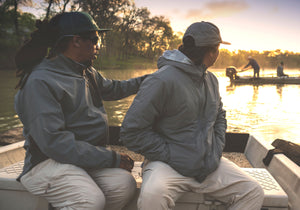Wading is an exhilarating part of fly fishing. It allows you to get up close with the fish and their environment. But entering any type of water — especially wild water — can be dangerous if you’re unprepared.
Follow these eight tips for safe wading when fly fishing.

1. Wear the right clothing
It’s essential that you have suitable clothing for wading. Even in warm weather, rivers and streams can be extremely cold — so you need the right protective clothing to stay safe when wading. As a minimum, you should have:
- Waders
- Wading boots
- Polarised sunglasses
- Wading jacket.
Waders and wading jackets
Waders keep you warm and dry when you’re in the water. Made from robust materials like polyester, nylon, and neoprene, a good pair of waders will ensure you can stay in the water for long periods of time without getting cold.
Waders can also protect you from injury if there are jagged rocks and branches beneath the water. Browse our waders collection to find the right pair for you.
Wading jackets may not be necessary in hot weather. But if you’re angling in cooler weather, they can keep you warm, dry, and comfortable.
Wading boots
Wading boots help you keep your footing in the water when you’re walking on slippery rocks or unsteady riverbed terrain. Choose from rubber or felt soles. Felt gives you a lot of grip, so it’s ideal for slippery underwater surfaces, but felt-soled boots aren’t great for hiking. Snow can cling to the felt, and wet grassy banks can be treacherous. Rubber-soled boots are preferable in these cases, and if you’re fishing in areas where rocks are less slippery. They work well on sand and gravel surfaces, as well as walkways and trails. Add studs to the bottom of your boots for extra grip.
2. Wading belt and life jacket
Always make sure you wear a life jacket or vest (PDF – Personal Floatation device just in case.
Because your waders are waterproof, they can easily start to fill up if you fall in the water. A wading belt restricts the amount of water that can get into your waders if you fall, preventing the excess weight from anchoring you down. You can also use a belt pack, which can replace a wading belt or be used in conjunction with one.
4. Only wade when you need to
Wading is a great way to get up close and personal with the water — but it’s not essential. In many cases you can fly fish successfully from the shore or riverbank. By only wading when you need to, you reduce the risk of falling in or getting too cold — especially if you don’t have the right clothing. You’re also less likely to spook the fish.
5. Find the right spot
If you are going to wade, it’s essential to find a safe spot to do it. The shallowest part of the river or stream is a good place to start. From here, you can carefully shuffle forward to find a safe route across the water.
Try to place your feet on large, firm, flat rocks, especially if you’re wading in rubber-soled boots. Felt-soled boots can have more grip on smooth round rocks, but you should still take extra care on these surfaces.
It’s important to note that in some areas felt boots aren’t allowed, as they’re more likely to harbour invasive species. Rubber-soled boots are easier to disinfect, and allow you steady hiking and wading in lots of different areas, including beaches, gravel, and mud.
6. Travel against the current
When crossing a river, you should travel at an angle rather than straight across. Turn to look slightly upstream, and wade towards the current. This is especially important in deeper or faster-flowing rivers, which can quickly become overpowering. If you get too tired to continue, you can simply turn back, allowing the current to push you in the direction you’ve come from.
7. Use a wading staff
A wading staff can give you extra stability in the water. Keep it close to your body and use it to feel out the terrain beneath your feet. If you trip or fall, the staff can help you stay on your feet. To maintain stability, make sure you always have two points of contact on the riverbed. Move your foot or your staff, but not both.
8. Train your dog
It can be rewarding to take your dog fly fishing, but if they have poor recall, they can be a hazard. Make sure your dog is well-trained, especially around water. If your dog gets into difficulty in the water, never put your own life in danger to rescue them. Instead, call 999 and follow their instructions.
9. Wade before you cast
Casting while you wade can distract you from positioning your feet, causing you to trip and fall. Don’t cast until you’ve found a safe, study position from which to fish.
Learn more about wading safely in this video:

